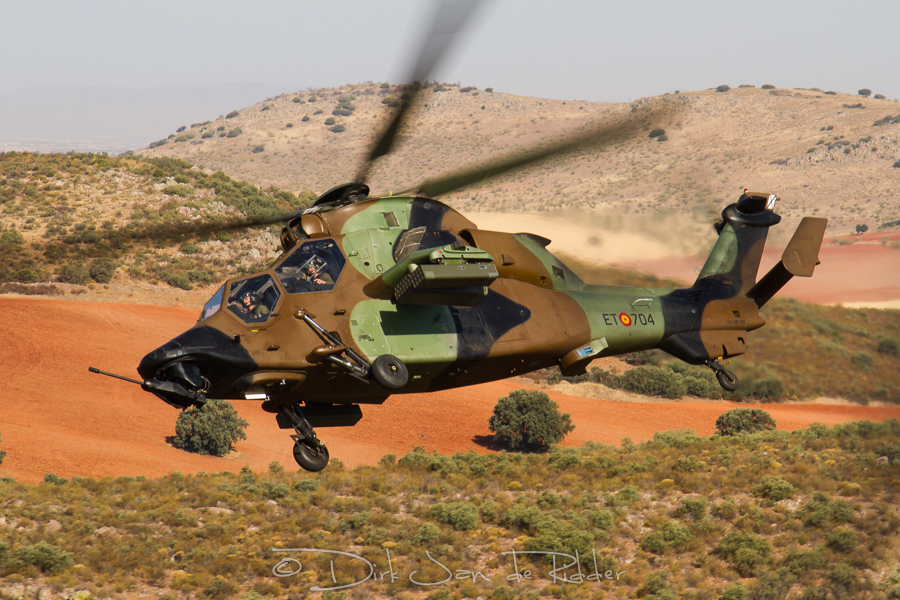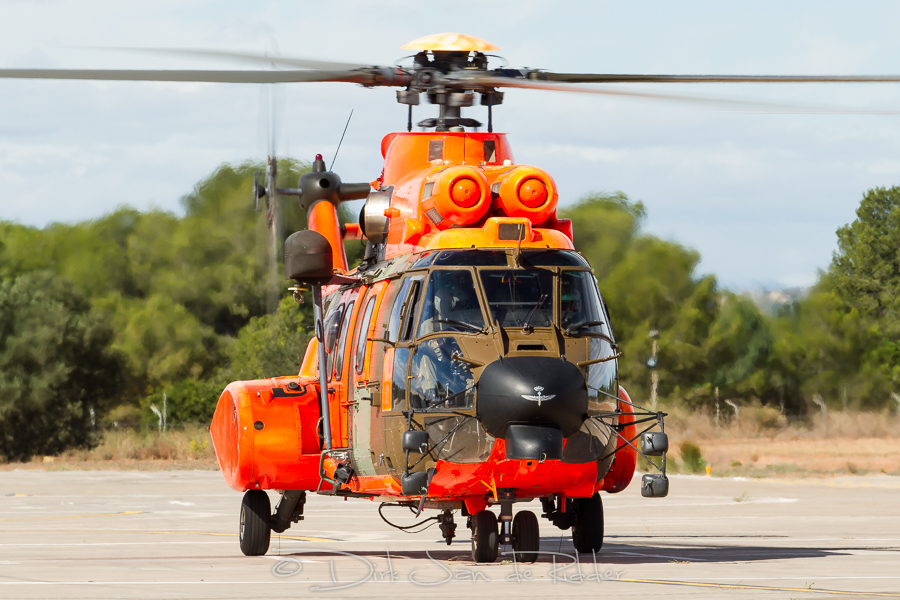Tigerland – BHELA I

Battallón de Helicópteros de Attaque Número I (BHELA I – Attack Helicopter Battalion I) is the only attack helicopter unit of the Spanish Army. It was established in 1980 at Colmenar Viejo, but in 1983 -while flying the Bo-105- it moved to Almagro when construction of its new base was completed. Almagro is located some 100 miles (160 km) south of Madrid in the Castilla-La Mancha region, well known for its wine production, oliveyards, windmills and from the early 17th century novel Don Quixote. In fact, the tiny city of Almagro was the setting for part of this novel.
In September 2003, the Tigre HAD (Helicóptero de Apoyo y Destrucción – Support and Attack Helicopter) was selected to replace the MBB Bo-105. A total of 24 were ordered, of which six HAP variants (the P standing for Protección/Protection) would be delivered early for training purposes and upgraded later. The other 18 Tigre HADs would be delivered between 2007 and 2011. During my visit to the base in September 2012, the battalion operated the initial six helicopters, but the first and so far only Tigre HAD was still test flying from Albacete.
Before the arrival of the first Tigres in spring of 2007, eight pilots were sent to France for training. They were initially trained at the Eurocopter factory at Marseille-Marignane, after which they joined their French and German colleagues at Le Luc-Le Cannet. At the end of 2007 they completed their training with night operations from their homebase. The current procedure for Tigre pilots is to be trained at Almagro, but two Spanish instructor pilots are based with the Franco-German pilot school at Le Luc. About two to three Spanish students receive their training in France each year.
Initially, they are trained in the front seat, which -in contrast with many other attack helicopters- is the pilot position. Depending on a number of criteria, including a pilot’s experience and whether he is an officer or a non-commissioned officer, he may move on to the gunner seat later. It is not compulsory to be an officer to become a gunner though. As long as there is an officer in the lead helicopter, the gunner in the second helicopter can be an experienced non-commissioned officer. Also, the Spanish Army lets some pilots remain in the pilot position to increase their experience.

BHELA I is divided into two companies, both of which operate the Bo-105 ‘Bölkow’ as well as the Tigre. When it comes to the pilots, some of them fly just one helicopter, while several fly both in order to log enough flying hours. Captain Suárez, a Tigre pilot, explains: “Several Bölkow pilots are waiting for the moment to become a Tigre pilot. We also have Tigre pilots with lots of experience, especially instructor pilots, who don’t fly the Bölkow anymore. It is better for flight safety if some pilots specialise in one helicopter, but the majority of the pilots fly both.”
“Converting to the Tigre means a complete change of missions for the battalion. The Bölkow was oriented towards recce [reconnaissance] and anti-tank missions, while the Tigre is a modular helicopter. Depending on the mission, we can adapt the weapon load to perform the same missions of the Bölkow, but additional missions as well. For example, we can now perform convoy escort, air convoy escort and close air support.”
At some point in the near future, when all of the Tigres have arrived, the decision will probably be taken to retire the Bo-105. Base personnel could not confirm if and when this will happen. For now, the helicopter is just serving too well as an affordable alternative for pilots to maintain their flying hours. Pilots don’t need to fly the Tigre all the time in order to maintain their skills in communicating with air traffic control and ground troops, to fly tactically at low level and to maintain their skills in operating as part of a patrol.

The simulators are another major money saver. A brand new building on base houses four gigantic simulators, two of which are full motion simulators. Each one is made specifically for a pilot or a gunner, so two crews can practice at any one time. Not only can they practice missions with each other, the simulator is also connected to Chinook and Cougar simulators elsewhere in the country, so the Tigre crews can practice with up to two Chinook and two Cougar crews. Any type of terrain can be simulated with one press on the button, including Afghanistan, Lebanon, Spain and the fictional ‘Tigerland’.
The current Tigre HAP can be armed with Mistral air-to-air missiles, 68mm unguided rockets and 450 rounds of 30mm ammunition in the cannon. It is unable to fire guided air-to-ground missiles, mainly due to the lack of a laser designator. When the Tigre HAD arrives, the Spike-ER air-to-ground missile will be added to its weapon arsenal, and the 68mm rockets will be replaced by 70mm rockets. Both crew members can perform all tasks and launch weapons, except for the Spike-ER which can only be fired by the gunner in the back.

Despite the fact that the Tigre HAP is not fully up to all requirements and that pilots basically start ‘from scratch’ without any experience in a comparable weapon system, the battalion is not simply training pilots basic flying manoeuvres until the more advanced Tigre HAD arrives. From the start on, the unit’s main goal has always been to train at the highest possible level. Tigre crews already have experience performing air interdiction, close air support, convoy escort, recovery of aircrew shot down over enemy territory (in cooperation with special forces units), as well as with firing all the helicopter’s weapons by day and night.
In Spring of 2012, Initial Operational Capability was reached, meaning that the unit is now ready to deploy for any mission worldwide, with the objective of supporting ground troops with three helicopters for a maximum period of one year. Experience gained from the French Army has learnt that 25 personnel would be needed for such a deployment.
By the beginning of September 2012, the six Tigres had logged 5600 flying hours. The first two Tigre HADs are now expected to be delivered at the end of 2012. Another four will arrive in 2013, followed by five in 2014 and seven in 2015. The conversion of the first six helicopters to Tigre HAD will be completed in 2017. The Tigre HAD will feature the 14% more powerful MTR390E engine and an improved optical sighting system with laser designator, as well as a new electronic warfare system, laser and radar warning receivers, improved ballistic protection and missile launch detectors coupled to chaff and flare dispensers.
A full report appeared in several magazines, including in Rotorblatt:






Comments are closed.